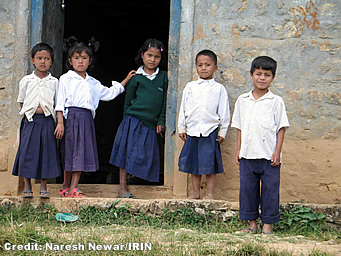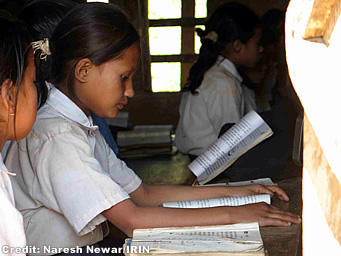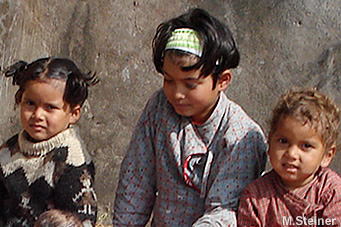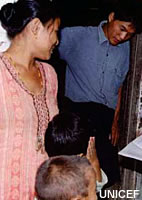|
Education
in Nepal: Reports
|
 |
Nepal EDUCATION |
|
|
 |
|
Education
for all - Review from a conflict perspective
|
 |
International
Alert, 31 March 2006

|
 |
| The
EFA programme has been relatively successful in distributing scholarships
to dalits but the amount actually received is commonly half what was intended
and very small in relation to the overall cost of education.
Scholarships
are nowhere near enough to compensate for the loss of labour when children
are sent to school. With government staff rarely if ever visiting schools,
ostensibly because of the conflict, there is ample scope for patronage
especially in the case of scholarships for '50 percent of poorer girls'.
In practice, resources are focused on the District towns while interior
areas are neglected. |
|
There
has been considerable progress in primary-level enrolment, and there is
now good representation of minorities and girls, but many classrooms are
extremely overcrowded. The system for appointing and transferring teachers
is inflexible, non-transparent and ineffective. There are now serious imbalances
in the spread of teachers, with classes of over a hundred common in the
terai (plains) while classes in hilly and mountain areas may typically
have less than ten children.
School
Management Committees have little alternative but to employ additional
teachers, often paid for by contributions from parents and remunerated
at far below the official rate. These additional hires count for 19 percent
of all teachers. Teachers' unions are alienated by this spread of low-paid
and informally-contracted employment. Overcrowding has also led communities
to construct extra classrooms by raising funds locally; usually by imposing
a levy per student. There is a risk that poorer children may be excluded,
although these negative effects appear to be counteracted to a considerable
extent by increasingly positive attitudes towards education.
Although
School Management Committees constitute an important step towards decentralization,
their budgets are so small that they have little freedom of choice. Virtually
the entire budget has to be devoted to fixed costs. They prepare School
Improvement Plans for presentation to the District Education Officer, but
the process of decision-making is non-consultative and lacks transparency.
The District Education Officers, for their part, complain that they are
given arbitrary budgets by the government, without meaningful consultation
or relationship to the needs of particular areas.
 |
| Problems
of implementation reduce the programme's ability to address social and
economic exclusion. But the conflict itself has moved into a more overtly
political phase focused around political rather than social and economic
exclusion. Many of the problems in EFA implementation arise not simply
from resource constraints but from an almost complete lack of functioning
consultative processes. The problem of overcrowding cannot be addressed
because teachers have adamantly opposed transfers of staff and greater
devolution of power, as in the case of Community Managed Schools. For their
part, local communities feel that government is not sharing with them the
cost of rising expectations. |
|
They note that officials rarely visit the
schools and that when they are called to the District town it is to be
talked at rather than discussed with.
There
has been little real consultation with representative groups, notably teachers,
communities and organisations concerned with the rights of minorities.
The agenda within the EFA programme revolves around a narrow debate between
donors, officials and a few academics. This has led to a focus on issues
that are peripheral in relation to current causes of dissatisfaction and
conflict. For example, groups representing dalits and janjatis are concerned
about the issue of wider representation within the educational system rather
than being assigned restricted roles relating to their ethnicity or social
status.
Such
groups call for attention to deeper problems. There is an increasing divide
between government and private schools and a deep social division between
those educated in Nepali language and those educated in English. This is
not simply because English is increasingly a requirement for higher-paid
employment. The education system delivers success to those who study in
English and failure to those who study in Nepali. The success rate for
children from private schools in the School Leaving Certificate examination
is about 80 percent while the success rate for children from government
schools is only 20 percent. In order to sit for the examination, children
have to pass through ten years of schooling with internal examinations
at each stage. The rate of repetition and drop-out is very high indeed,
especially in Grade 1 with nearly half the children having to repeat the
Grade or dropping out. Only 16 percent of children complete primary education
and the number is further reduced in the five further secondary Grades
before the SLC exam. Thus, less than one child in twenty who enters the
state education system achieves the basic pass.
The
reasons for failure in the SLC examination relate to deficiencies in government
schools and in the examination system rather than any fault of the children.
Most children from government schools faced with a practical test in science
will inevitably fail if their school had no laboratory or scientific equipment.
They
fail in English because it was not used regularly in the classroom, and
the expected standard is now based more on the practice of private schools
where English is the medium of instruction. If they fail in one subject,
they fail the whole SLC. Such children have good reason to blame the system,
and may leave school in a state of anger and frustration.
Why
do failures of implementation persist? Few officials now send their children
to government schools - a fifth of children now attend private schools
and the proportion is increasing. Officials have no personal stake in the
state education system. But a more fundamental problem is the distrust
characterizing all current relations between officials and people. A more
open and consultative style of government would undoubtedly improve matters.
Better relationships could be established with teachers' unions and other
representative groups. The issue of imbalance in teacher distribution could
then be addressed.
Some
observers consider that such fundamental changes will have to wait until
the political crisis is resolved. Grievances are becoming intensely politicised
and there is a tendency to want to blame government rather than solve problems.
But this argument can be turned the other way. The education sector could
play a leading role in conflict transformation by demonstrating consultative
and inclusive behaviour and by creating forums for discussion about such
pressing issues as privatization, English language education and examination
failure.
| Credit:
International Alert 2006 |
 |
top
|
Links
|
 |
 |
 |
Externe
Links |

|
|
Children
from Kavre village, Dolakha district
|
|









